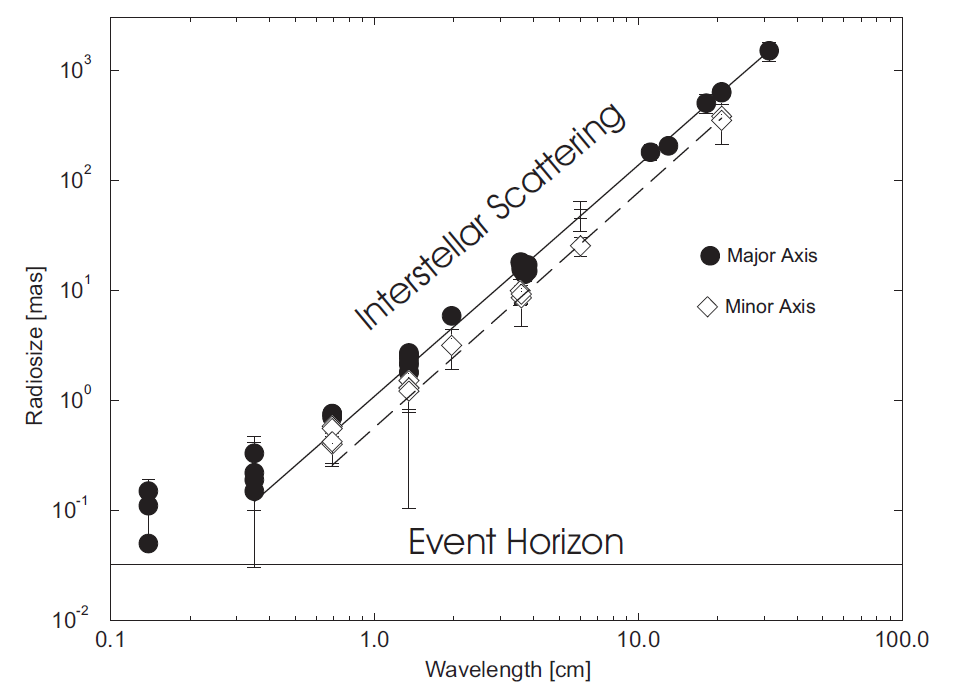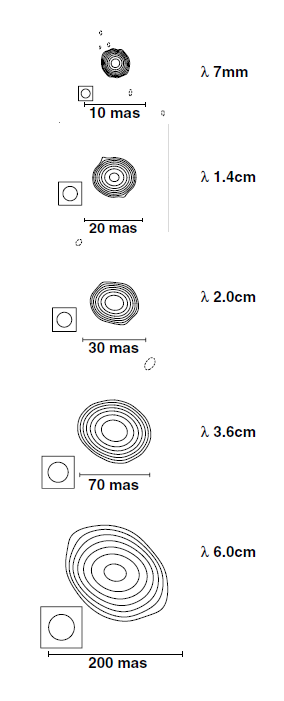
Size of Sgr A* VLBI observations
 المؤلف:
Heino Falcke and Friedrich W Hehl
المؤلف:
Heino Falcke and Friedrich W Hehl
 المصدر:
THE GALACTIC BLACK HOLE Lectures on General Relativity and Astrophysics
المصدر:
THE GALACTIC BLACK HOLE Lectures on General Relativity and Astrophysics
 الجزء والصفحة:
p 314
الجزء والصفحة:
p 314
 12-2-2017
12-2-2017
 2358
2358
Size of Sgr A* VLBI observations
A major issue for a long time has been the exact size and structure of Sgr A*. In extragalactic sources the VLBI technique has allowed one to probe deep into the hearts of active galactic nuclei (AGNs) and to resolve the radio structures into relativestically outflowing plasma jets (see, e.g., Zensus 1997). In a VLBI experiment radio telescopes distributed over a continent or the entire world are synchronized by atomic clocks and jointly observe one source. The incoming radio waves are digitized and stored (usually on magnetic tapes). Later, the digitized waves are correlated in a specialized computer recreating a virtual interferometer. Such a virtual interferometer will have a spatial resolution similar to that of a giant telescope with the diameter of roughly the separation of the

Figure 1.1. The major source axis (filled circles) of Sgr A* and the minor source axis (open diamonds) as measured by VLBI plotted versus wavelength (adapted from Krichbaum et al 1999). The inclined lines show the λ2 scattering law and the horizontal line shows the size scale expected for the visual imprint of the event horizon (Falcke et al 2000).
individual telescopes (called ‘baselines’). This technique has yielded by far the highest-resolution images in astronomy (i.e. < 50 μarcseconds at 86 GHz). The image quality improves with the number of participating telescopes and the two major VLBI arrays today are the European VLBI Network (EVN) and the Very Long Baseline Array (VLBA) in the United States.
Of course, a prominent source such as Sgr A* has been a prime target for VLBI experiments over the last 25 years. It is from these observations that we have direct information on the size of the source or at least have very tight upper limits.
It was, however, quickly realized that, despite its relative proximity, detecting the true structure of Sgr A* is unusually difficult compared to other galactic nuclei. The reason is that interstellar material in the line of sight towards the Galactic Center scatter broadens the VLBI image. This produces a characteristic λ2 law (e.g. Scheuer 1968) for the size of Sgr A* as a function of the wavelength λ (Davies et al 1976, van Langevelde et al 1992, Yusef-Zadeh et al 1994, Lo et al 1998). The scattering size apparently has not changed over a decade (Marcaide et

Figure 1.2. Contour plots of VLBA images of Sgr A* at wavelengths of λ = 6.0, 3.6, 2.0, 1.35, and 0.7 cm. These images are smoothed to a circular beam of FWHM = 2.62λ1.5cm mas as shown at the bottom left-hand corner on each image. The contours are 2 mJy beam−1 × (−2, 2, 4, 8, 16, 32, 64, 128, 256). Figure from Lo et al (1999).
al 1999). For that reason the intrinsic size and structure of Sgr A* has remained obscure until today (figures 11.4 and 11.5). The measured size of Sgr A* is given by (Lo et al 1998)
θminor = 0.76 mas(λ/cm)2 θmajor = 1.42 mas(λ/cm)2. (1.1)
The front line of this research is currently at wavelengths of 7 mm and shorter. Lo et al (1998) and Krichbaum et al (1993, 1998) claim to have seen evidence for a deviation from the scattering law at these wavelengths. Other experiments did not directly confirm this (Rogers et al 1994, Bower and Backer 1998, Doeleman et al 2001). The main problem is that Sgr A* is never above 25o elevation at the VLBA and mm-VLBI is strongly affected by the variable atmosphere. Significant distortions of the phase (of the radio waves) can happen on timescales of 10 s at the short wavelengths. Therefore mm-VLBI observations of Sgr A* are difficult to calibrate and are always subject to intense scrutiny and nagging doubts.
However, the rapid variability of Sgr A* with timescales of 10 minutes (X-rays) to 3 h (15 GHz radio) suggests that time-variable structure may exist on similarly short timescales. We can estimate a scale for adiabatic cooling of a plasma by using equation (1.1), convert to a linear size at the Galactic Center distance DGC = 8 kpc, and divide by the maximal sound speed of a relativistic plasma (photon gas; see, e.g., Konigl 1980) cs = c/√3. We get
 (1.2)
(1.2)
Hence, if for example, matter is ejected during one of the big X-ray flares near the black hole it could, in principle, cool and fade away within a few hours at most radio wavelengths. Consequently, there is no reason why VLBI observations separated by one day will always look the same.
 الاكثر قراءة في الثقوب السوداء
الاكثر قراءة في الثقوب السوداء
 اخر الاخبار
اخر الاخبار
اخبار العتبة العباسية المقدسة


